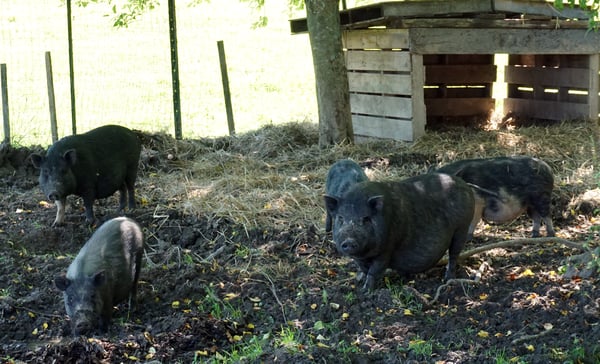NELSONVILLE, Ohio—Robbin’s Crossing might not be open for visitors yet, but it has some new residents.
Five American Guinea hogs moved into the historical interpretation site May 18. Purchased from a small homestead farm near Johnstown, Ohio, the hogs will add to the existing livestock of chickens, turkeys and ducks at the site.
 “Having animals at Robbin’s Crossing really brings history to life,” Sasha Sigetic, program manager for Hocking College’s Agroecology program, said. “Given that this breed was historically raised by early settlers makes it all the more real.”
“Having animals at Robbin’s Crossing really brings history to life,” Sasha Sigetic, program manager for Hocking College’s Agroecology program, said. “Given that this breed was historically raised by early settlers makes it all the more real.”
American Guinea hogs are believed to be descended from Red Guinea hogs that were brought to the country by Thomas Jefferson and other Virginia farmers in the early 19th century. Crossbreeding with other hogs is believed to have created the American Guinea—making it a truly American breed.
By the 1880s, both Guinea breeds had fallen out of favor resulting in the disappearance of the Red Guinea, with the American Guinea nearly succumbing to the same fate. As it stands the American Guinea is considered a threatened breed by the Livestock Conservancy—a group dedicated to protecting endangered livestock and poultry breeds.
 “Breeds like this are important because they are heartier than most common commercial breeds, are calmer and easier to handle in temperament and won’t exceed the weight most FDA approved butchers accept for processing,” Sigetic said.
“Breeds like this are important because they are heartier than most common commercial breeds, are calmer and easier to handle in temperament and won’t exceed the weight most FDA approved butchers accept for processing,” Sigetic said.
The hogs should only become 150-200 lbs., according to the Livestock Conservancy.
The five hogs currently at Robbin’s Crossing are all female, but Sigetic said the college plans to acquire a boar in the spring. Four of the five females will be harvested, with the remaining sow and the boar enabling the college to continue to raise American Guineas.
“They’re great homestead and small farm pigs that won’t get too large no matter the length of time we have them,” Sigetic said.
 Hocking College Agroecology students will care for the passel of hogs as part of their Livestock I and II classes. Students in the program will name the hogs soon.
Hocking College Agroecology students will care for the passel of hogs as part of their Livestock I and II classes. Students in the program will name the hogs soon.
Robbins Crossing is a collection of authentic log homes that allows students in Hocking College's Parks and Museum Education program to practice living history presentations in period clothing. The village engages visitors in the skills and lifestyles of the past, including blacksmithing, wood stove cooking and woodworking.
More About Agroecology at Hocking College
Are you concerned about the global food crisis, diminishing soil health, polluted waterways, etc? Do you want to grow and market food for local communities? Or do you want to discover how to model nature on the path to creating sustainable agriculture and the next food revolution?
Students in Hocking College’s Agroecology program learn how to do all of those things by using ecology to evaluate the productivity of agricultural systems including the dynamics between technological advances, biophysical interactions, socioeconomic relationships, and the geology and geomorphology of a region.
Traditional production agriculture is changing as people begin to question where the food they eat comes from, what chemicals were used, if it was genetically modified or if growth hormones were used. Smaller farms can use the techniques learned in Agroecology to choose and grow higher-value crops and livestock.
Students learn hands-on techniques at the college’s farm in Logan, Ohio, and indoor facilities that will give them the technical job skills and professional judgment to work independently.
For more information about the Agroecology program, contact Program Manager Sasha Sigetic by email at sigetics@hocking.edu or by phone at 740-753-6283.




